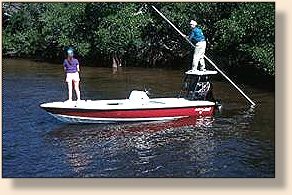 The tempo is intoxicating. Plant. Push. One after another, hand-over-hand,
you plant and push. The cadence is intoxicating. Ever so slowly you glide
over the turtle grass, white holes; you can make out each pebble of sand.
Looking through gin-clear water small stones seem like yellow patches where
grass refuses to grow. Trout and redfish bed deep into this grass. As
predator and provider, they instinctively know to hide from the cold. The
grass flat's shallowness is deceiving, if you step on it, you'll find yourself
waist deep in mud.
The tempo is intoxicating. Plant. Push. One after another, hand-over-hand,
you plant and push. The cadence is intoxicating. Ever so slowly you glide
over the turtle grass, white holes; you can make out each pebble of sand.
Looking through gin-clear water small stones seem like yellow patches where
grass refuses to grow. Trout and redfish bed deep into this grass. As
predator and provider, they instinctively know to hide from the cold. The
grass flat's shallowness is deceiving, if you step on it, you'll find yourself
waist deep in mud.
 Pushing along and stalking intensifies your concentration. The angler awaits
your command. Minutes seem like hours, but they melt away with each push
of the pole. One, two, three, four – pull the pole up and outward, then replant it.
There is an art to poling. A local captain from Volusia is one of the best around.
He puts his weight to the stick like a pole-vaulter. Crunch-man, that's his nickname,
leans back bending the pole. Ever so slightly he positions himself for the push.
He takes a quick look forward and makes small adjustments. Then as gracefully
as he leaned back he releases his energy and the pole accelerates the boat forward.
He can change direction, accelerate or stop. His command of a flats boat is
a testament to stamina and practice.
Pushing along and stalking intensifies your concentration. The angler awaits
your command. Minutes seem like hours, but they melt away with each push
of the pole. One, two, three, four – pull the pole up and outward, then replant it.
There is an art to poling. A local captain from Volusia is one of the best around.
He puts his weight to the stick like a pole-vaulter. Crunch-man, that's his nickname,
leans back bending the pole. Ever so slightly he positions himself for the push.
He takes a quick look forward and makes small adjustments. Then as gracefully
as he leaned back he releases his energy and the pole accelerates the boat forward.
He can change direction, accelerate or stop. His command of a flats boat is
a testament to stamina and practice.
I watch as ripples of water pass along the gunnels. A small current of water
leaves a trail at the stern, evidence of our forward progress. Out of the corner
of an eye, I catch movement ahead. Fixed now on the object making a v-shaped
wake, I move ahead towards the push. Poling has an affect, it transfixes me.
My mind races ahead, a post-release to the staking of these mighty fish.
The rhythm frees my mind. Soon I'm over the schooling redfish. They are
beautiful to watch as they glide over the sea of grass and sand. For only a
moment I'm one with the pole. We are closing on the school.
We can't move faster because the rush of water will alert the fish to our presence.
The tempo has to be constant, deliberate. Each pole push has to be released.
Like a paddlewheel making the turns with each blade entering the water at the
same rate. It is like that with the pole. There is an aerobic, short, but constant
tempo to the pushes. I keep the flats boat moving at about three miles per hour.
In the last fifty yards the pace is slowed. The closer we get to these fish the more
sensitive they will be us. Now my angler can see those copper forms. Fifty
redfish are moving to the right. The pole is planted and pushed at ninety degrees
and hard away from the starboard gunnel. Slowly the bow swings to the right.
Planted and motionless she casts leading the fish. A strike is eminent. Seconds
later the water explodes with a hook up and the rest of the school explodes.
Line jets off the spool; the pole pushes towards the running fish. I follow now
as fast as possible to get the fish, then boat and release him.
Once the chase is over, the poling regime is started again. It's the music of the
Lagoon. Dancers on their platforms. Locate the school. Start the chase.
Plant and push. One after another. ~ Doug.
About Doug:
Doug is a USCG Licensed Captain and fly-fishing guide from New Smyrna Beach, FL
a member of CCA, FFF, AFF, APCA, FOWA, the Action Craft Saltwater Team,
and the Orvis and Redington Pro-Guide Program. He can be reached at 386-679-5814.
|





